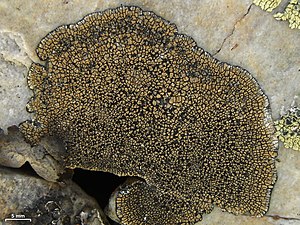Sporastatia
| Sporastatia | |
|---|---|

| |
| Sporastatia testudinea growing on a rock in Wheeler Peak, Nevada, USA | |
| Scientific classification | |
| Kingdom: | Fungi |
| Division: | Ascomycota |
| Class: | Lecanoromycetes |
| Order: | Rhizocarpales |
| Family: | Sporastatiaceae |
| Genus: | Sporastatia A.Massal. (1854) |
| Type species | |
| Sporastatia testudinea (Ach.) A.Massal. (1855)
| |
| Species | |
| Synonyms[1] | |
| |
Sporastatia is a genus of crustose lichens in the family Sporastatiaceae. It has four species.[2] Sporastatia lichens are long-lived species that grow on siliceous or weakly calcareous rocks in arctic and alpine locales.
Taxonomy
Sporastatia was circumscribed by Italian lichenologist Abramo Bartolommeo Massalongo in 1854, with Sporastatia testudinea assigned as the type species.[3] The name Gyrothecium, proposed by William Nylander in 1855,[4] is a synonym of Sporastatia.[1]
Following molecular phylogenetic studies published in 2013, Sporastatia was placed in a separate family, the Sporastatiaceae.[5] This family was shown to have a sister taxon relationship with the family Rhizocarpaceae, and together the two families comprise the order Rhizocarpales.[6]
Description
Characteristics of the genus include the crust-like thallus underlain by a black prothallus that is revealed around the margins; lecideine apothecia, and asci that contain 100–200 spores.[7]
Some Sporastatia species are hosts for lichenicolous fungi, including Rhizocarpon pusillum, R. asiaticum, and Miriquidica invadens.[7]
Species
- Sporastatia crassulata Yakovch. & Davydov (2018)[7] – Altai Mountains
- Sporastatia karakorina (Obermayer & Poelt) Davydov & Yakovch. (2018)
- Sporastatia polyspora (Nyl.) Grummann (1963)
- Sporastatia testudinea (Ach.) A.Massal. (1854)
The taxon Sporastatia desmaspora (C.Knight) C.W.Dodge (1970) is now known as Biatorella desmaspora.[8]
References
- ^ a b "Synonymy: Sporastatia A. Massal., Geneac. lich. (Verona): 9 (1854)". Species Fungorum. Retrieved 26 September 2021.
- ^ Wijayawardene, Nalin; Hyde, Kevin; Al-Ani, Laith Khalil Tawfeeq; Somayeh, Dolatabadi; Stadler, Marc; Haelewaters, Danny; et al. (2020). "Outline of Fungi and fungus-like taxa". Mycosphere. 11: 1060–1456. doi:10.5943/mycosphere/11/1/8.
- ^ Massalongo, A. (1854). Geneacaena lichenum noviter proposita ac descripta (in Latin). p. 9.
- ^ Nylander, W. (1855). "Essai d'une nouvelle classification des lichens (second mémoire)". Mémoires de la Société Impériale des Sciences Naturelles de Cherbourg (in Latin). 3: 186.
- ^ Bendiksby, Mika; Timdal, Ernst (2013). "Molecular phylogenetics and taxonomy of Hypocenomyce sensu lato (Ascomycota, Lecanoromycetes) — extreme polyphyly and morphological/ecological convergence". Taxon. 62 (5): 940–956. doi:10.12705/625.18.
- ^ Lücking, Robert; Hodkinson, Brendan P.; Leavitt, Steven D. (2017). "The 2016 classification of lichenized fungi in the Ascomycota and Basidiomycota–Approaching one thousand genera". The Bryologist. 119 (4): 361–416. doi:10.1639/0007-2745-119.4.361. S2CID 90258634.
- ^ a b c Yakovchenko, Lidia S.; Davydov, Evgeny A. (2018). "Sporastatia crassulata, a new species from the Altai Mountains with a key to Sporastatia and remarks on some additional species". The Lichenologist. 50 (4): 439–450. doi:10.1017/S0024282918000282. S2CID 91256059.
- ^ "Record Details: Sporastatia desmaspora (C. Knight) C.W. Dodge, Nova Hedwigia 19(3-4): 482 (1970)". Index Fungorum. Retrieved 26 September 2021.
Error: "Q10676167" is not a valid Wikidata entity ID.
- CS1 Latin-language sources (la)
- Articles with short description
- Short description with empty Wikidata description
- Articles with 'species' microformats
- Taxonbars desynced from Wikidata
- Taxonbar pages requiring a Wikidata item
- Taxonbars with invalid from parameters
- Taxonbars without secondary Wikidata taxon IDs
- Lecanoromycetes
- Lecanoromycetes genera
- Taxa described in 1855
- Taxa named by Abramo Bartolommeo Massalongo